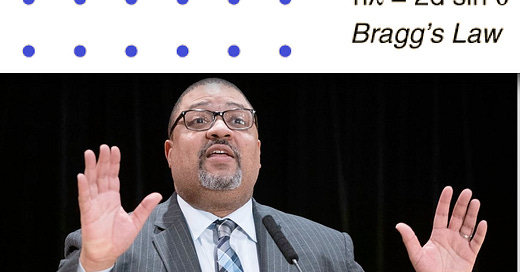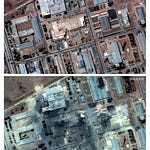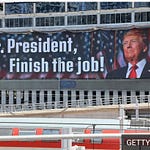In the marble halls of Manhattan’s criminal justice system, District Attorney Alvin Bragg unveiled an indictment on December 17th suggesting that criminal law, like quantum mechanics, allows for a single act to exist in multiple, mutually exclusive states. His office charged Luigi Mangione with first-degree murder as terrorism, second-degree murder as terrorism, and regular second-degree murder - a legal superposition that would make Schrödinger reconsider his cat experiment.
“In its most basic terms,” Bragg explained, “this was a killing intended to evoke terror.” With this appeal to fear fallacy (argumentum ad baculum) conversation ending characterization, Manhattan’s top prosecutor launched a dubious experiment in temporal mechanics where evidence time-travels, buildings commit terrorism by existing, and Twitter metrics prove past intentions.
The transformation from standard homicide to multimodal terrorism occurred with breathtaking speed. On December 4th, NYPD Chief of Detectives Joseph Kenny stated: “The motive for this murder currently is unknown.” By December 17th, this uncertainty had evolved into a comprehensive terrorism theory powered by evidence that didn’t exist until after the arrest.
Bragg’s Box of Legal Legos
Bragg’s theoretical legal framework suggests several novel propositions about the nature of reality:
First, selecting “one of the most bustling parts of our city” for a crime automatically elevates it to terrorism. Under this theory, Midtown Manhattan itself becomes a terrorism enhancement zone - the first case of real estate committing terrorism through simple existence.
Second, public reaction can retroactively establish criminal intent. “We’ve seen a real increase sustained increase since December 4th in concern,” offered Deputy Commissioner Rebecca Winner, inadvertently suggesting that social media engagement metrics can travel backward in time to prove motivation.
Third, the corporate status of the victim - UnitedHealthCare being “the fifth largest corporation in America” - somehow proves pre-crime terrorist intent, despite investigators learning this detail after arrest. ("Corporations are people, my friend," Mitt Romney said at the 2011 Iowa State Fair.)
Prosecutorial Time Travel
The prosecution’s evidence timeline defies traditional causality:
November 24-December 4: Planning period (evidence pending Twitter reaction)
December 4: Crime occurs
December 4-9: Investigation focuses on basic identification
December 9: Arrest via civilian tip
December 17: Past terrorist intent discovered through future events
When asked to explain how post-crime reactions prove pre-crime intent, Bragg demonstrated remarkable flexibility in causality: “The intent was to sow terror.” The fact that this intent materialized two weeks after arrest through social media analysis apparently poses no logical difficulties.
We Have Seen This Before
New York’s terrorism statute has evolved through case law in ways that present particular challenges for Bragg’s legal lasagna:
People v. Morales (2012)
The court established three critical elements for terrorism charges:
Specific intent must be proven through pre-crime evidence
Political or social objectives must be documented before the act
Population coercion must be primary goal, not incidental effect
Outcome: Terrorism charges dismissed when prosecution could only show post-crime social impact rather than pre-crime intent. The court specifically noted that “public reaction cannot retroactively establish criminal intent.”
Bragg’s Theory Problem: Relies entirely on post-crime reaction and social media analysis to prove pre-crime intent.
Matter of Jose D. (2019)
Required prosecution to demonstrate:
Contemporaneous documentation of terrorist intent
Clear connection between political agenda and target selection
Evidence of planning phase political motivation
Outcome: Appellate Division upheld dismissal of terrorism charges where target selection alone was used to prove political intent. The court emphasized that “location choice cannot substitute for documented political agenda.”
Bragg’s Innovation: Claims midtown building selection itself proves terrorist agenda, precisely what Jose D. rejected.
People v. Richardson (2015)
Established the “temporal causality requirement”:
Intent evidence must predate the crime
Political motivation must be provable without reference to results
Target significance alone cannot establish terrorist intent
Outcome: New York’s highest court overturned terrorism conviction where prosecution relied on post-crime public reaction to prove pre-crime intent.
Bragg’s Law of Retro-activity: Uses Twitter engagement metrics from December 5-17 to prove November 24 intentions.
Bragg’s Legal Qubits
The charging structure creates what physicists might call multiple legal states simultaneously. If evidence supports first-degree terrorism, it logically excludes second-degree terrorism. If it only supports second-degree terrorism, it cannot simultaneously prove first-degree. The prosecution has achieved a state where success on any charge mathematically guarantees failure of another.
The precedential framework creates a formula for terrorism charges:
P(Terrorism Conviction) = [Pre-Crime Evidence × Documented Intent × Political Agenda]
Bragg’s quantum equation attempts to solve this with variables that don’t exist until after the crime:
∣ψ⟩ (Terrorism) = [α∣0⟩ (Future Twitter Posts) × β∣1 (Building Location) × γ∣2 (Corporate Status)]
Buildings Are Terrorists, My Friend
If this prosecutorial theory prevails, it would effectively transform New York’s terrorism statute from a tool for prosecuting politically motivated violence into a quantum field where any crime generating sufficient Twitter engagement becomes retroactive terrorism. The first person to jaywalk in Times Square might find themselves charged with terrorizing pedestrian infrastructure.
The statutory requirements for terrorism charges present particular challenges:
New York law requires specific intent to:
Influence or coerce civilian population
Impact government policy
Advance political/social objectives
The prosecution satisfies these through several remarkable legal innovations:
Building selection equals political agenda
Corporate victim status proves anti-capitalist motivation
Twitter engagement metrics establish pre-crime intent
Time flows in whatever direction most benefits the charges
Circular Conclusions
The indictment raises fundamental questions about the relationship between public reaction and criminal intent, between architecture and terrorism, between institutional ambition and the laws of physics. As this case proceeds through the court system, it may establish precedents in both criminal law and quantum mechanics.
In Manhattan’s criminal justice system, it seems a single criminal act can exist in multiple, mutually exclusive states until collapsed by a jury - assuming the jury’s decision doesn’t retroactively change the original crime through social media engagement.












Share this post